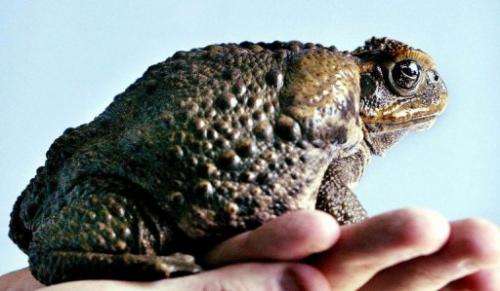Australian wildlife taught to shun cane toads

Australia's native animals are being fed nauseating sausages of cane toad meat in a bid to train them against eating the foul, toxic species as it spreads into new areas, researchers said on Tuesday.
Cane toads, a warty, leathery creature with a venom sac on their heads toxic enough to kill snakes and crocodiles, are advancing across north-western Australia at a speed of 50 kilometres (31 miles) a year.
They were first introduced to Australia from Hawaii to control scarab beetle populations in the 1930s and have now reached pest proportions, breeding prolifically and with few predators.
Native animals, particularly small marsupials and lizards, will die if they eat a full-grown adult and conservationists are attempting to give them a repellent first taste of toad to train them against seeing it as food.
Tiny sausage-shaped baits made of cane toad flesh with the poison removed have been laid out in native quoll, dingo, snake and lizard habitats, laced with a salt that induces instant nausea, forcing the animal to spit it back out.
"The animals are therefore likely, if they encounter anything and they bite it and it tastes like a toad, smells like a toad, they're going to remember back to that horrible experience," David Pearson, from Western Australia's Department of Environment and Conservation, told AFP.
Field trials were already showing success, with motion-sensitive cameras at the bait sites recording animals eating and then spitting out the sausages.
Dingoes, a native wild dog, had been seen to "pick up one of these things, go a couple of metres and then spit it out and roll all over it," Pearson said.
The baits were designed to see native wildlife through the first wave of toads into a new region. The earliest toads to arrive are usually particularly large and toxic, and it was important to avoid them, Pearson added.
Quolls, a carnivorous marsupial also commonly known as the native cat, have become endangered in parts of northern Australia due to the spread of cane toads and Pearson said it could take a local population "decades" to regenerate, upsetting fragile native ecosystems.
There was no known way to kill or control cane toads and Pearson said only climate—a lack of water or cooled conditions—would act as a natural brake on their rapacious march across Australia.
"They're in the landscape but at least, with these baits, we'll still have our native predators in the landscape as well," he said.
(c) 2012 AFP

















